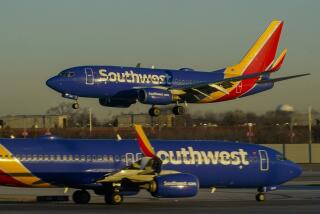Wi-Fi up high: Row44 Web access for airlines gets a test flight over Las Vegas
I’m flying 4,000 feet above the desert near Las Vegas on a cloudless day, with a spectacular view out the window of majestic mountains, dramatically stark landscapes and shimmering lakes.
So, what am I looking at?
A dog riding a skateboard.
That’s because on this flight I have access to YouTube and all other aspects of the Internet, which are normally unavailable on airplanes.
This is a demonstration during the annual Consumer Electronics Show of Row44, a soon-to-debut satellite Wi-Fi system for commercial airlines.
Later this month, Row44 will have a public trial run aboard selected Southwest and Alaska airlines flights.
“Now there’s no way to avoid work,” shouts pilot Dave Cummings above the engine noise of Row44’s test aircraft, a Grumman seaplane that was new in the 1950s.
Indeed, it’s easy to e-mail and surf the Web on the connection that offers DSL-type speeds as we bank in a slow turn over the MGM Grand and head out over the desert.
The signal, coming from the Horizons-1 satellite 22,300 miles above Earth, is picked up by an antenna hidden under a small metal canopy atop the seaplane.
Using a combination of GPS, laser and other technologies, the antenna continuously moves to stay pointed at the satellite.
Videos stream seamlessly for entertainment, and the Internet is way better for shopping than any copy of SkyMall magazine. During the 20-minute flight, which includes a brief stop on Lake Mead, I order an opera DVD and a video game from Amazon.com.
I don’t try a Skype voice call because of the plane’s noise, but Gregg Fialcowitz, president of Row44, says Skype has been tested several times with Row44 and works well. An airline that adopts the system, however, could electronically block Internet voice calls, which might be a good idea considering the prospect of sitting within earshot of someone Skyping all the way from L.A. to New York.
Row44 Chief Executive John Guidon says instant messaging also works well, which would be a far more socially acceptable airborne form of communication.
Speaking of acceptability, how about the prospect of the person next to you on a flight surfing porn sites? Fialcowitz says an airline could use a commercially available blocking service, such as Net Nanny. The company has the ability to block individual sites from being viewed on its system, but it could never hope to block all the porn locales.
“That would be a losing battle,” Fialcowitz says.
The Internet connection is briefly lost during a turn over the lake too steep to allow the antenna to receive the satellite.
The connection is lost again as we head back toward the Strip and turbulence tosses the small plane about.
“This wouldn’t happen so much on a commercial flight,” Guidon says as several aboard report a touch of nausea.
Airline Wi-Fi has been tried before. In 2000, Boeing announced its Connexion for large airliners. But the system, far heavier and more expensive to run than Row44’s, faded out in 2006.
Southwest and Alaska passengers who get on the right flight will soon be able to try Row44 for themselves, free. Southwest is installing it on four of its jets; Alaska is putting it on one.
Pricing, if the system is adopted by an airline, hasn’t been determined.
But who could put a price on seeing that cute doggie?
More to Read
Inside the business of entertainment
The Wide Shot brings you news, analysis and insights on everything from streaming wars to production — and what it all means for the future.
You may occasionally receive promotional content from the Los Angeles Times.











